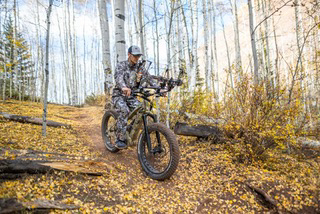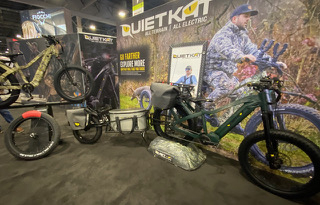As Outdoor Wire Publisher Jim Shepherd noted from the SHOT show last week, there very well may be.
 |
The idea of even getting on a bicycle may seem strange to most of us who haven’t traveled on two wheels since we were old enough for a driver’s license. While avid suburban conditioning fans may ride 10-speeds, for most of us bikes are just a distant memory unless our kids or grandkids are riding them.
They shouldn’t be. New models with electric power-assist not only make bikes more practical for a lot more of us, they open up new uses uniquely suited to two-wheel transportation—including great hunting and fishing access to remote areas and beaches throughout the nation.
The off-road versions of E-bikes now available make it possible to travel miles into difficult terrain on trails that are too narrow for full-sized vehicles, and to do it in silence, with almost no impact on the habitat or the wildlife. This gives them a huge advantage over noisy four-wheel ATV’s, a favorite of many hunters in deer and turkey seasons.
Scouting for springtime turkeys becomes far easier because it’s possible to roll along at a steady pace, three or four times your walking speed, while calling with a diaphragm call in your mouth and listening for a response. You don’t have to be quite so careful that there’s not a rattler or a moccasin watching your next step, either!

This display version at SHOT Show is carrying a cooler, but the single wheel cart is more than capable of bringing you and your harvest home on wheels. OWDN photo.
|
And getting to a distant deer stand without alerting every deer close by also becomes far easier when you can travel the woods on a noiseless E-bike rather than in a truck or ATV. Add a single-wheel cart and you’ve also got an easy way to carry your deer out, without the long drag back to the truck many of us have faced.
When it comes to fishing, add a rod holder and the bikes make it possible to ride long distances along streamside trails to reach distant honey-holes, or to travel the woods to your remote pond quickly and easily, even on some roads impassable to four-wheel vehicles—though you may have to push them around the deepest mud bogs.
And if you’re looking for pompano holes along the beach, the e-bike makes it quick and simple to cover miles of shore that you could never check on foot. (You’ll have to deflate the tires a bit to roll over soft sand, and of course give the bike a freshwater bath afterwards.)
The bikes are simple to operate and easy to ride. The model I have currently, the QuietKat Apex, took me about five minutes to become comfortable with—and I haven’t been on a bike in decades. It’s a nine-speed with a 48-volt lithium battery hidden in the frame, enough to travel 30 to 60 miles, more or less, depending on the terrain and how much you pedal to assist the electric motor.
And you can pedal as much, or as little, as you want. The QuietKat has five electric motor power settings—level 1 is barely walking speed, while level 5 is faster than you can run on level ground. You’re likely to use the top power mostly for serious hill climbing or plowing through mud. There’s also the usual mechanical gearing, giving a wide choice of pulling power for varying terrain.
You can kick in the electric assist in two ways—either by mashing down a throttle on the left handle bar or by pedaling—either one engages the motor at the pre-set level you’ve punched in on the central monitor, a cell-phone-sized screen that sits in the center of the handle bars.
Level 1 or 2 is most manageable for those new to E-Bikes. Just as in riding a standard bicycle, you can easily shift the mechanical gears via the shift levers on the right handlebar. It is important to start off in a low, easy gear, shifting to higher gears when you get up to speed. The wide range of gears is great for everything from a smooth flat road to steep uphill pulls or over rough or muddy terrain.
The fat, knobby tires can be deflated to as little as 10 psi to allow them to roll over mud or sand without bogging down. On harder ground or pavement, pump them up to 25 psi for a faster ride and less wear on the tread.
The hydraulic brakes are controlled by handlebar levers—you use the rear brake for general slowing, the front for extreme downhill where the back wheel may lose traction, and both together for emergency stops when a deer bolts out in front of you!
In most use, you can ride the bike several days between recharges, and it recharges in a few hours when plugged into the included charger. The company says the battery will last around 1,000 cycles, or 20,000 to 24,000 miles for most users, which is way more than most of us are ever going to ride an E-bike.
A few tips from my experience:
The bikes from Quiet Kat range in price from the $2,400 Ranger up to the $6,700 Jeep model, and financing is available on their website. The Voyager folding model, about $3,000, is designed for transport aboard RV’s, boats and in smaller cars. A plus with this company is that they allow a 30-day trial, if you’re not sure you want an E-bike—ride it less than 10 miles and you can ship it back for only the cost of shipping: see details at www.quietkat.com.
SIDEBAR: E-Bikes for Exercise
E-bikes are not only a great way to get into the backcountry, they are also a pleasant way to exercise.
Wait a minute, you may be saying—you’re riding a motorized bike—how does that equate to any exercise?
But for those of us not quite in shape for the Olympics anymore, the option of adding just a bit of electrical assistance makes it possible to take on roads we never could manage otherwise, while still getting a really good workout.
You set the power assist at 0 on roads your legs can handle, increasing the assist to 1 or 2 on modest hills, and all the way up to 5 on really steep terrain. You can make your ride as intense as you want by adding just enough power to allow you to manage the bike—believe me, you’ll feel the burn.
— Frank Sargeant
Frankmako1@gmail.com